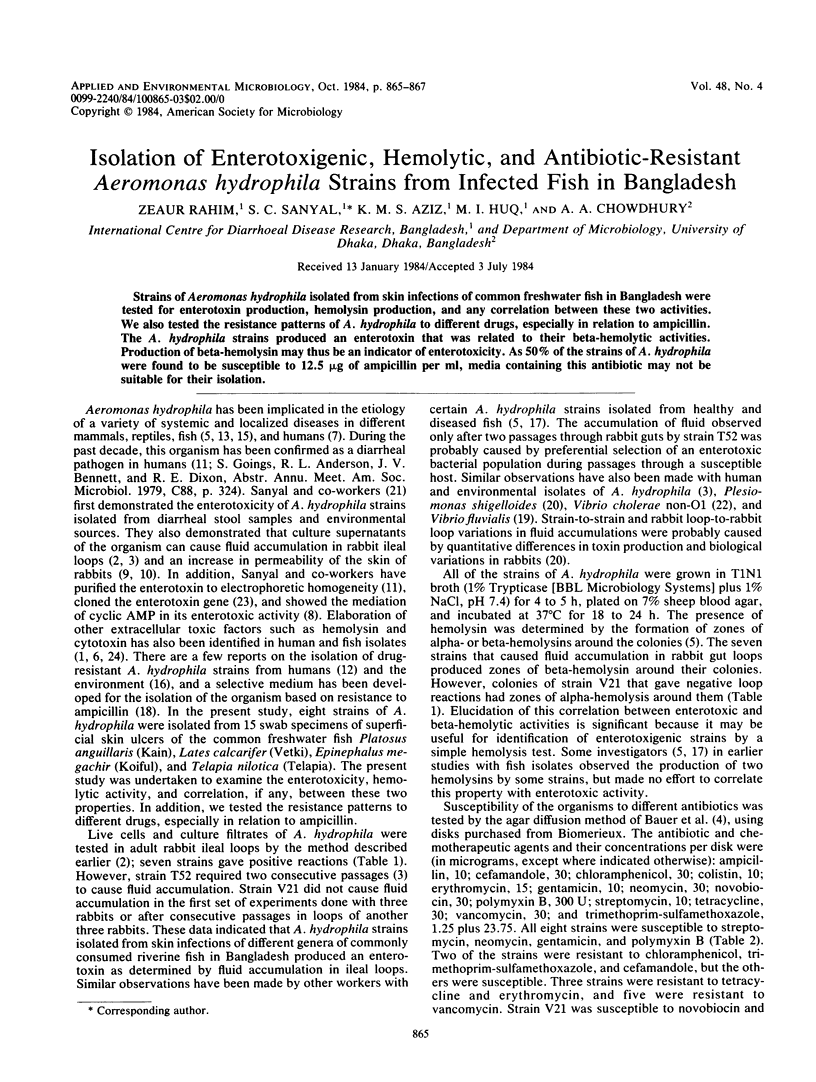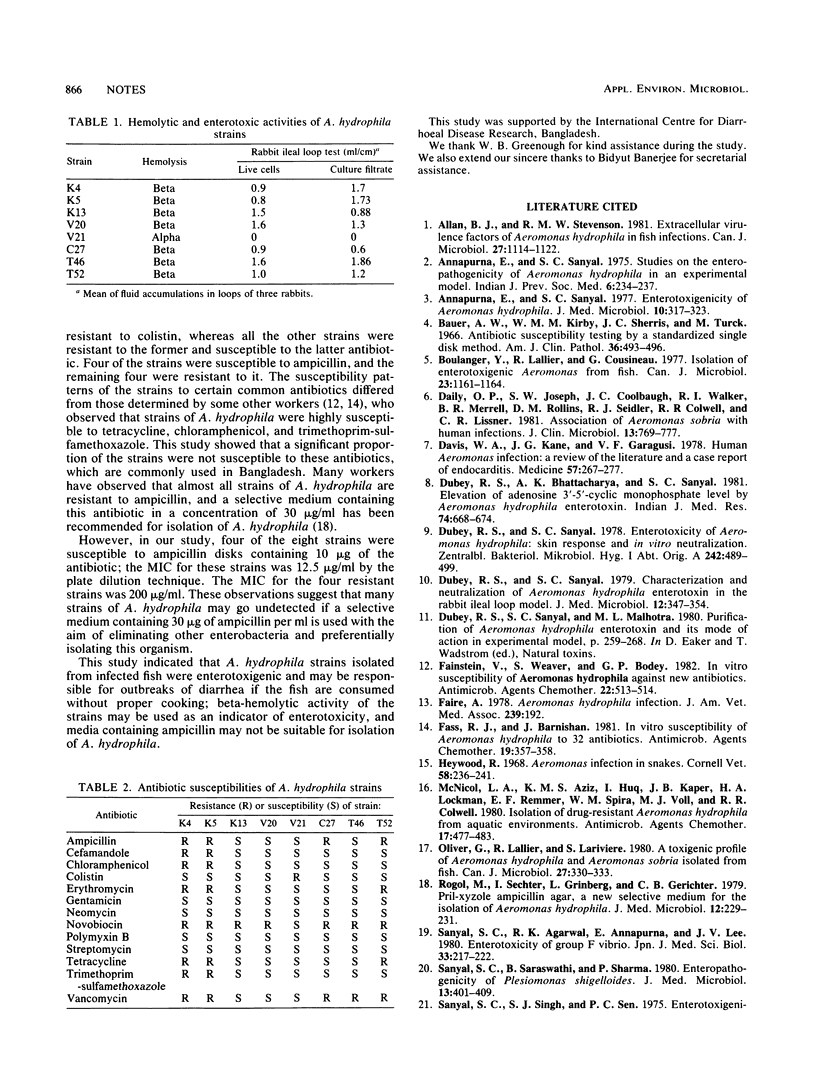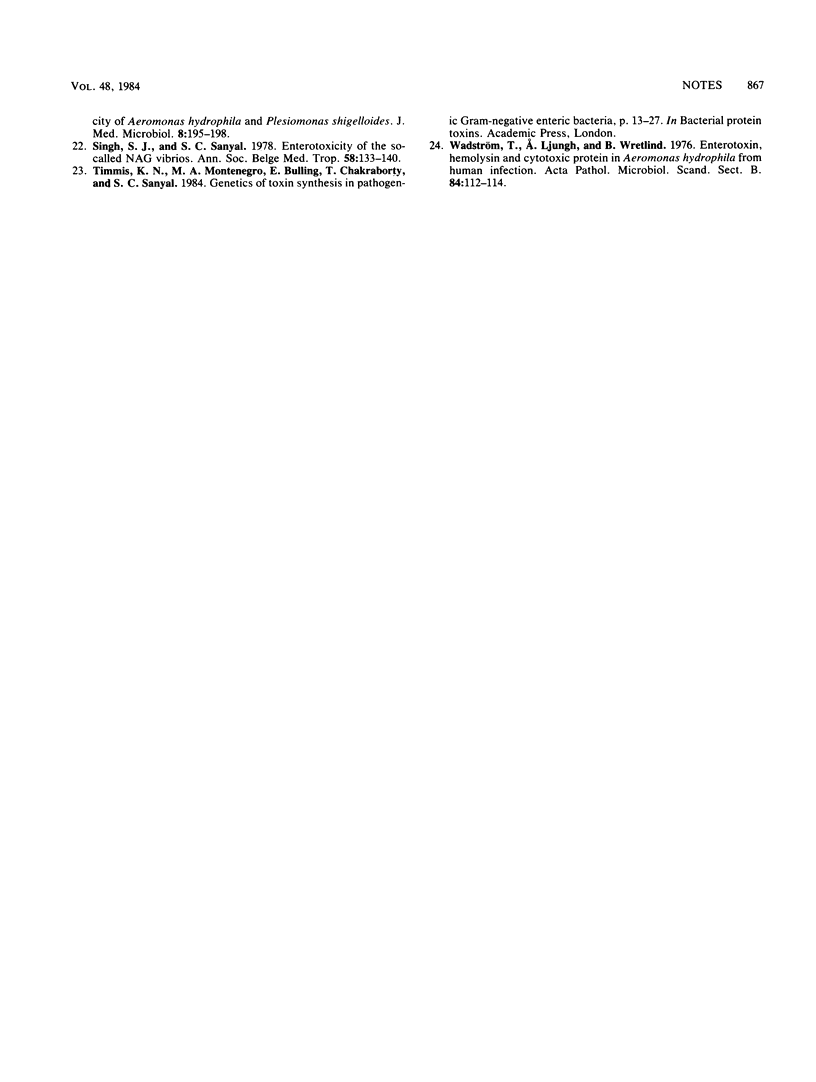Abstract
Strains of Aeromonas hydrophila isolated from skin infections of common freshwater fish in Bangladesh were tested for enterotoxin production, hemolysin production, and any correlation between these two activities. We also tested the resistance patterns of A. hydrophila to different drugs, especially in relation to ampicillin. The A. hydrophila strains produced an enterotoxin that was related to their beta-hemolytic activities. Production of beta-hemolysin may thus be an indicator of enterotoxicity. As 50% of the strains of A. hydrophila were found to be susceptible to 12.5 micrograms of ampicillin per ml, media containing this antibiotic may not be suitable for their isolation.
Full text
PDF


Selected References
These references are in PubMed. This may not be the complete list of references from this article.
- Allan B. J., Stevenson R. M. Extracellular virulence factors of Aeromonas hydrophila in fish infections. Can J Microbiol. 1981 Oct;27(10):1114–1122. doi: 10.1139/m81-174. [DOI] [PubMed] [Google Scholar]
- Annapurna E., Sanyal S. C. Enterotoxicity of Aeromonas hydrophila. J Med Microbiol. 1977 Aug;10(3):317–323. doi: 10.1099/00222615-10-3-317. [DOI] [PubMed] [Google Scholar]
- Bauer A. W., Kirby W. M., Sherris J. C., Turck M. Antibiotic susceptibility testing by a standardized single disk method. Am J Clin Pathol. 1966 Apr;45(4):493–496. [PubMed] [Google Scholar]
- Boulanger Y., Lallier R., Cousineau G. Isolation of enterotoxigenic Aeromonas from fish. Can J Microbiol. 1977 Sep;23(9):1161–1164. doi: 10.1139/m77-174. [DOI] [PubMed] [Google Scholar]
- Daily O. P., Joseph S. W., Coolbaugh J. C., Walker R. I., Merrell B. R., Rollins D. M., Seidler R. J., Colwell R. R., Lissner C. R. Association of Aeromonas sobria with human infection. J Clin Microbiol. 1981 Apr;13(4):769–777. doi: 10.1128/jcm.13.4.769-777.1981. [DOI] [PMC free article] [PubMed] [Google Scholar]
- Davis W. A., 2nd, Kane J. G., Garagusi V. F. Human aeromonas infections: a review of the literature and a case report of endocarditis. Medicine (Baltimore) 1978 May;57(3):267–277. [PubMed] [Google Scholar]
- Dubey R. S., Bhattacharya A. K., Sanyal S. C. Elevation of adenosine 3' 5' cyclic monophosphate level by Aeromonas hydrophila enterotoxin. Indian J Med Res. 1981 Nov;74:668–674. [PubMed] [Google Scholar]
- Dubey R. S., Sanyal S. C. Characterisation and neutralisation of Aeromonas hydrophila enterotoxin in the rabbit ileal-loop model. J Med Microbiol. 1979 Aug;12(3):347–354. doi: 10.1099/00222615-12-3-347. [DOI] [PubMed] [Google Scholar]
- Dubey R. S., Sanyal S. C. Enterotoxicity of Aeromonas hydrophila: skin responses and in vivo neutralisation. Zentralbl Bakteriol Orig A. 1978 Dec;242(4):487–499. [PubMed] [Google Scholar]
- Fainstein V., Weaver S., Bodey G. P. In vitro susceptibilities of Aeromonas hydrophila against new antibiotics. Antimicrob Agents Chemother. 1982 Sep;22(3):513–514. doi: 10.1128/aac.22.3.513. [DOI] [PMC free article] [PubMed] [Google Scholar]
- Fass R. J., Barnishan J. In vitro susceptibilities of Aeromonas hydrophila to 32 antimicrobial agents. Antimicrob Agents Chemother. 1981 Feb;19(2):357–358. doi: 10.1128/aac.19.2.357. [DOI] [PMC free article] [PubMed] [Google Scholar]
- Heywood R. Aeromonas infection in snakes. Cornell Vet. 1968 Apr;58(2):236–241. [PubMed] [Google Scholar]
- McNicol L. A., Aziz K. M., Huq I., Kaper J. B., Lockman H. A., Remmers E. F., Spira W. M., Voll M. J., Colwell R. R. Isolation of drug-resistant Aeromonas hydrophila from aquatic environments. Antimicrob Agents Chemother. 1980 Mar;17(3):477–483. doi: 10.1128/aac.17.3.477. [DOI] [PMC free article] [PubMed] [Google Scholar]
- Olivier G., Lallier R., Larivière S. A toxigenic profile of Aeromonas hydrophila and Aeromonas sobria isolated from fish. Can J Microbiol. 1981 Mar;27(3):330–333. doi: 10.1139/m81-050. [DOI] [PubMed] [Google Scholar]
- Rogol M., Sechter I., Grinberg L., Gerichter C. B. Pril-xylose-ampicillin agar, a new selective medium for the isolation of Aeromonas hydrophila. J Med Microbiol. 1979 May;12(2):229–231. doi: 10.1099/00222615-12-2-229. [DOI] [PubMed] [Google Scholar]
- Sanyal S. C., Agarwal R. K., Annapurna E., Lee J. V. Enterotoxicity of group F vibrios. Jpn J Med Sci Biol. 1980 Aug;33(4):217–222. doi: 10.7883/yoken1952.33.217. [DOI] [PubMed] [Google Scholar]
- Sanyal S. C., Saraswathi B., Sharma P. Enteropathogenicity of Plesiomonas shigelloides. J Med Microbiol. 1980 Aug;13(3):401–409. doi: 10.1099/00222615-13-3-401. [DOI] [PubMed] [Google Scholar]
- Sanyal S. C., Singh S. J., Sen P. C. Enteropathogenicity of Aeromonas hydrophila and Plesiomonas shigelloides. J Med Microbiol. 1975 Feb;8(1):195–198. doi: 10.1099/00222615-8-1-195. [DOI] [PubMed] [Google Scholar]
- Singh S. J., Sanyal S. C. Enterotoxicity of the so-called NAG vibrios. Ann Soc Belg Med Trop. 1978;58(2):133–140. [PubMed] [Google Scholar]
- Wadström T., Ljungh A., Wretlind B. Enterotoxin, haemolysin and cytotoxic protein in Aeromonas hydrophila from human infections. Acta Pathol Microbiol Scand B. 1976 Apr;84(2):112–114. doi: 10.1111/j.1699-0463.1976.tb01911.x. [DOI] [PubMed] [Google Scholar]


